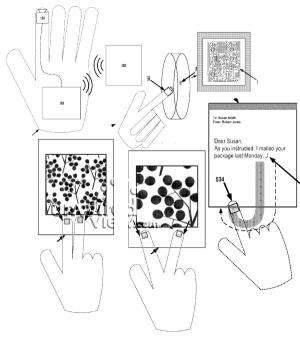August 25, 2012 weblog
Google seeing-hand patent shows smart glove ambitions

(Phys.org)—Google has been granted a patent for devices and methods for getting information with one's hands. Their patent is titled "Seeing with your Hand."
Google watchers say this is a harbinger of Google's plans to come up with the mother of all smart gloves, a missing part of the Project Glass puzzle that just could be the full solution to wearable computing. While Glass has strong potential for augmented reality input through the eyes, Google is turning to hand in glove to interact with the virtual world. The recent glove-based patent spells out possibilities of getting and conveying information through hand control.
The patent was applied in July 29 of last year and this month was published. Among the inventors listed on the patent is one Sergey Brin.
"Humans naturally use their hands and fingers as a means of gathering information. For example, when moving in a dark environment, humans naturally put their hands out to gather information about their surroundings by touch. Similarly, when a small object is lost, for example, underneath a couch, humans naturally put their hands under the couch to locate the lost object by touch," says the patent application.
"In addition to gathering information, humans also naturally use their hands and fingers to convey information. For example, when giving someone directions to a location, many humans naturally use one or more fingers to point towards the location. Similarly, when discussing a particular object, many humans naturally use one or more fingers to point to the object. However, typically the amount and types of information that can be conveyed by a human's hands is limited to specific contexts."
That inspired the inventors at Google to look for devices and methods for gathering and conveying information with a hand.
In order to "see" an inaccessible environment, says the patent, a user may wear a device equipped with one or more detectors on one of his or her hands, or on other areas of the user's body.
The smart glove suggested by the inventors carries out specific services which they describe. The glove's cameras can act as magnifiers. The motion detectors, gyroscopes, and accelerometers can support navigation type applications similar to those on smartphones,. Wireless communication technology could facilitate data transfer between the smart glove users, or enable users to take part in mobile commerce.
Services like these will be carried out by a smart glove crammed with electronics—cameras on the fingertips, motion detectors on the fingers, a CPU, RAM and storage and wireless communication chips on the back.
Outside Google, technological explorations for deploying information using the hand are nothing new as evidenced in previous research. Studies dating back to the 1990s have examined the notion of glove-based input
One such piece of research is by Vitor F. Pamplona and colleagues who wrote a paper called "The Image-Based Data Glove," Proceedings of X Symposium on Virtual and Augmented Reality, in 2008. "Data gloves are devices equipped with sensors that capture the movements of the hand of the user in order to select or manipulate objects in a virtual world." Though data gloves were introduced three decades ago, said the authors, "good data gloves are too expensive and only a few of them can perceive the full set of hand movements."
The authors proposed a device that uses a camera to track visual markers at finger tips, and a software module to compute the position of each finger tip and its joints in real-time. They also talked about turning their prototype into a low-cost interaction device.
More information: patft.uspto.gov
© 2012 Phys.Org




















